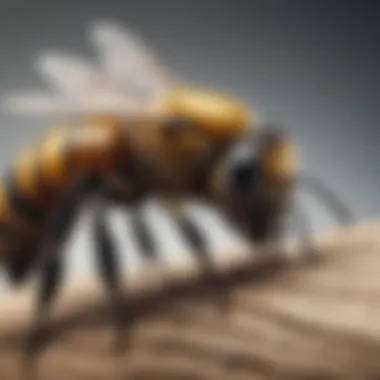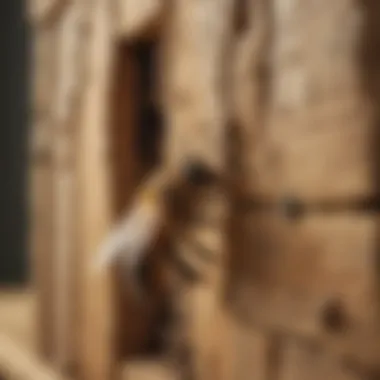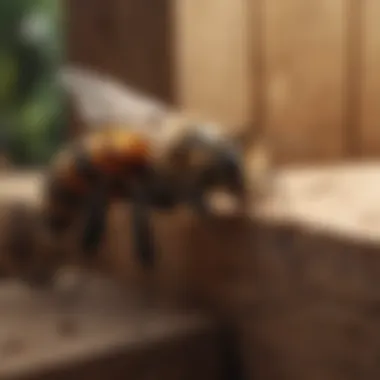Understanding and Managing Wood Boring Bees


Intro
Wood boring bees, though often overlooked, play a significant role in our ecosystem. These fascinating insects contribute to pollination while being notorious for their ability to damage wooden structures. Understanding their biology and behavior is essential for homeowners wishing to protect their property. This article aims to shed light on the impact of wood boring bees, discuss management strategies, and emphasize the importance of a balanced outdoor environment.
Through the exploration of wood boring bees’ habits, we will identify effective prevention methods and discuss how to manage infestations. Whether you are a homeowner or someone interested in maintaining outdoor spaces, this guide will equip you with the knowledge needed to tackle potential issues arising from these pests.
Understanding Wood Boring Bees
Wood boring bees belong to a specific group within the bee family, primarily known for creating tunnels in wood. Unlike typical bees, these insects utilize dead or decaying wood for nesting. Their larvae feed on the wood, which can lead to structural damage over time.
Biology and Behavior
Wood boring bees exhibit intriguing behaviors. They typically emerge in the spring when temperatures rise, seeking suitable locations to create nests. Their lifecycle begins with mating, followed by the female laying eggs in the wood. The larvae then hatch and start tunneling, which can result in significant damage if left unchecked.
Common species of wood boring bees include:
- Xylocopa virginica (Eastern Carpenter Bee)
- Ceratina spp. (Small Carpenter Bees)
Understanding the specific species prevalent in your area can assist in targeting management techniques effectively.
Identifying Infestation
Detecting the presence of wood boring bees is crucial in preventing extensive damage. Common signs of infestation include:
- Visible entrances or exit holes in wood surfaces.
- Sawdust or frass near entry points.
- Hollow sounds when tapping on infested wood.
Homeowners should conduct regular inspections of wooden structures, especially during spring and early summer when bees are most active.
"Regular inspection can prevent significant damage caused by wood boring bees within your property."
Management and Prevention Strategies
Managing wood boring bees requires a multi-faceted approach. It is not only about addressing existing infestations but also implementing preventive measures.
Preventive Measures
Some effective strategies to protect wooden structures include:
- Sealing Wood Surfaces: Use paints or sealants to create a barrier.
- Removing Decayed Wood: Regularly check and replace any rotting wood in structures.
- Creating Disincentives for Nesting: Utilize chemical deterrents if necessary, but ensure they are safe for the environment.
Management Techniques
If a wood boring bee infestation is identified, consider the following steps:
- Professional Assessment: Engage pest control experts specializing in bees.
- Localized Treatment: Apply targeted treatments to infested areas instead of broad-spectrum solutions.
- Monitoring: Regularly check the treated areas to ensure no further activity.
With careful attention to management strategies, homeowners can mitigate the risks posed by wood boring bees.
Culmination
In summary, wood boring bees, while being integral to the ecosystem, can pose threats to wooden structures. By understanding their behavior and employing effective management strategies, homeowners can minimize potential damage. The balance between nature and our living environments can be achieved through informed action and continued education.
Learning to live with wood boring bees in a controlled manner is essential for creating healthy outdoor spaces.
Prologue to Wood Boring Bees


Understanding wood boring bees is essential for homeowners and anyone interested in maintaining wooden structures. These bees play a unique role in the ecosystem, but their woodworking habits can pose risks if left unchecked. Knowing how to manage and coexist with these creatures can save time, money, and effort in preserving your property.
Definition and Characteristics
Wood boring bees, belonging to various species within the families of carpenter bees and other related bees, create tunnels in wood for nesting. They are typically characterized by a robust body, often resembling bumblebees but usually larger and with smoother abdomens. The males are less aggressive and do not bore into wood, while females are responsible for the damage. These bees can be found in a range of environments, often opting for untreated wood and softwoods such as pine.
Important characteristics include their ability to create long, cylindrical tunnels within wood. The entrance hole can often be confused with that of other pests, making identification crucial for appropriate management.
Common Species in Different Regions
Several species of wood boring bees are found across different regions. Some of the most common include:
- Eastern Carpenter Bee (Xylocopa virginica): Predominantly found in the eastern U.S., they prefer untreated wood and can be seen during warm months.
- Western Carpenter Bee (Xylocopa californica): Common in the western U.S., these bees exhibit similar behaviors and nesting patterns to their eastern counterparts.
- Periclytus species: Found in various parts of the world, these bees also bore into wood but usually prefer different types of habitats.
Beware of environmental factors that might increase their population, like excessive dampness or the availability of untreated wood. Understanding these species equips homeowners with the knowledge they need to identify and mitigate any potential issues.
Biology and Behavior of Wood Boring Bees
Understanding the biology and behavior of wood boring bees is crucial for homeowners concerned about the integrity of wooden structures. These bees, while fascinating in their ecological roles, have the potential to cause significant damage if left unchecked. Familiarizing oneself with their life cycle, nesting habits, and ecological contributions provides insights into effective management strategies.
Life Cycle Overview
The life cycle of wood boring bees encompasses distinct stages: egg, larva, pupa, and adult. Each stage plays a critical role in the bee's development and impacts the health of the wooden structures they inhabit. Female wood boring bees select suitable wood for nesting, often preferring softwoods like cedar or pine. Upon laying eggs within the wood, these eggs hatch into larvae. The larvae feed on the wood over several weeks, creating tunnels that can compromise structural integrity. As they mature, they transition to the pupal stage before emerging as adults. Understanding this cycle assists in identifying the timing for effective interventions. This knowledge also illuminates the urgency of preventive measures, as the damage typically compounds over time if not addressed promptly.
Nesting and Feeding Habits
Wood boring bees exhibit unique nesting behaviors. They typically tunnel into wood to create individual chambers for rearing their young. This tunneling can leave behind visible signs like small holes and sawdust. Feeding habits vary between species but often include the consumption of decaying wood, which is essential for larval development. This relationship with wood contributes to the breakdown of organic material in forest ecosystems but becomes a liability in man-made structures.
To mitigate risks, homeowners should be vigilant about the condition of outdoor wooden elements. A proactive approach includes regular inspections and timely treatments. Assessing the surroundings and managing wood piles can significantly reduce the chances of infestations.
Role in Ecosystem
Wood boring bees are not merely pests; they fulfil important ecological roles. They contribute to the decomposition of wood and the recycling of nutrients back into the soil. This process is integral to forest health, promoting biodiversity and supporting various life forms.
- Pollination Benefits: Many wood boring bees also serve as essential pollinators, helping plants reproduce and ensuring ecosystem balance.
- Habitat Creation: Their activities create habitats for other organisms, fostering a diverse community.
In an ecological context, the existence of wood boring bees highlights the need for a nuanced approach to pest management. Ignoring their beneficial roles can impair local ecosystems, complicating the balance between controlling infestations and promoting environmental health.
"The destruction caused by wood boring bees can be mitigated through informed management strategies. Educating oneself on their biology and behavior is the first step in maintaining both structures and ecosystems."
Integrating pest management strategies that account for their ecological roles allows homeowners to manage these bees effectively. Understanding their life cycle and nesting habits, as outlined, is paramount to protecting wooden structures while also appreciating the broader implications of their presence.
Identifying Wood Boring Bee Infestations
Identifying wood boring bee infestations is crucial for homeowners. These pests can silently damage wooden structures, leading to costly repairs. Early detection can save time and money. Understanding how to spot an infestation can also ease concerns about property damage. Knowledge of these signs allows for quick action. It empowers homeowners with critical information to manage pests effectively.
Signs of Infestation
Recognizing the signs of wood boring bees is essential. The first clue often comes from physical damage:
- Visible Holes: Small, round holes in wood are common indicators. These holes serve as entrances for the bees.
- Wood Fragments: Sawdust or small wood shavings near holes suggest active tunneling.
- Dead Bees: Finding dead bees around the area may highlight an existing problem.
The presence of these signs can indicate a larger infestation. Inspections should be thorough, especially in areas where wood is exposed.
Typical Areas Affected


Wood boring bees tend to affect specific parts of structures. Common areas for infestations include:
- Decks and Patios: These outdoor wooden structures are often at risk.
- Fencing: Wooden fences can provide an ideal nesting site.
- Siding: Softwood siding is particularly vulnerable. Look for signs around windows and doors.
Inspecting these areas regularly can help in early identification. The more attention given to suspected zones, the better the chances of controlling the infestation.
Distinguishing from Other Pests
Wood boring bees can be confused with other pests. Distinguishing them from termites or carpenter ants is vital. Here is how to tell them apart:
- Holes: Wood boring bees create smaller, round holes. Termite holes tend to be more random and not as distinct.
- Damage Patterns: Bees focus on specific areas, while termites damage wood more indiscriminately.
- Pest Activity: Look for active tunneling signs, which are often clear with wood boring bees but less so with others.
Understanding the differences can guide proper management steps. Each pest requires distinct approaches for effective removal.
"Effective identification and management are key to protecting your wooden structures and enhancing their longevity."
Preventive Measures for Wood Boring Bees
Preventive measures are critical when dealing with wood boring bees. These bees can cause significant damage to wooden structures if infestations are not managed properly. Proactive strategies are essential for homeowners to maintain the integrity of their properties. Implementing such measures not only prevents the initial establishment of these pests but also reduces the need for more drastic actions later.
Choosing Appropriate Building Materials
One of the first steps to prevent wood boring bee infestations is the careful selection of building materials. Opting for wood that has been treated for pest resistance can be very beneficial. For example, pressure-treated lumber is designed to withstand various environmental threats, including wood boring bees. Utilizing hardwoods like oak or teak can also reduce risks, as these species are typically less susceptible to damage.
It is also advisable to avoid using untreated softwoods for structures close to the ground or in damp areas. These are more likely to attract wood boring bees due to their softer texture. When constructing new wooden structures, consider incorporating materials like composite wood or other synthetic options that do not provide nesting opportunities for these bees.
Implementing Wood Treatment Solutions
Wood treatment solutions are another essential preventive measure. Applying treatments to the wood surfaces can create a protective barrier against wood boring bees. Borate-based preservatives are particularly effective. They penetrate deep into the wood to eliminate existing populations and deter new infestations.
Regularly reapplying these treatments can maximize effectiveness. It is important to follow the manufacturer’s guidelines for application and safety. Pay particular attention to areas that are exposed to moisture or have direct soil contact, as these are prime locations for wood boring bee activity.
Regular Maintenance and Inspections
Engaging in regular maintenance and inspections is key to sustaining the health of any wooden structure. Homeowners should routinely examine wooden elements both inside and outside their properties. Look for signs of damage, such as small holes or sawdust, which may indicate an active infestation.
Seasonal inspections should focus on:
- Checking wooden decks, fences, and siding.
- Cleaning gutters to prevent moisture accumulation.
- Maintaining proper drainage around buildings to deter bees seeking places to nest.
Taking timely action to repair any damage can significantly reduce the risk of significant infestations. Ensuring that wood remains dry and in good condition is an effective way to prevent problems related to wood boring bees.
Effective Removal Strategies
Effective removal strategies are crucial in managing wood boring bees and minimizing damage to wooden structures. Given their biology and behaviors, addressing an infestation is imperative to prevent long-term consequences. Timing, technique, and safety considerations all play significant roles in ensuring successful management.
Assessment of Infested Areas
The first step in any effective removal strategy is the assessment of infested areas. Identifying where wood boring bees have made their homes is essential. Look for distinct signs such as small holes in the wood and fine wood shavings on the ground. Often, these indicators suggest active nesting. It is also important to consider the extent of the infestation. Check both interior and exterior wooden structures, including decks, siding, and trees.
Make a note of any patterns, such as the location of most damage. This step not only guides you in making decisions on treatment methods but also helps in focusing efforts where they are most needed. Early assessment can prevent larger infestations and expensive repairs.
Physical Removal Techniques
Once you have assessed the infested areas, physical removal techniques can be employed. This may involve manually extracting infested wood. If you can clearly identify damaged sections, it may be best to replace them entirely. Proper tools such as chisels and saws should be used to carefully remove the affected wood without damaging surrounding areas.


After removal, ensure you dispose of the infested material properly to prevent any further infestations. Furthermore, sealing any openings after removal will help deter new bees from nesting in the same location. This method not only removes existing pests but also fortifies your structures against future threats.
Chemical Treatments and Safety Considerations
For more severe infestations, chemical treatments may be necessary. Various insecticides specifically targeting wood boring bees are available on the market. It is fundamental to follow manufacturer's instructions to ensure effectiveness and safety. Consider using products like deltamethrin or permethrin, which are designed for this purpose.
However, take safety precautions seriously. Make certain to wear protective gear, including gloves, masks, and goggles. Ensure proper ventilation when using chemical treatments indoors. Additionally, it may be valuable to understand local regulations regarding chemical use and disposal.
Ultimately, remember that chemical treatments should complement other management strategies rather than replace them. Regular monitoring and follow-ups may be required to confirm the effectiveness of treatments.
"Regular assessments and a holistic approach to pest management are essential for long-term success against wood boring bees."
Long-Term Management Solutions
Long-term management solutions for wood boring bees are crucial for minimizing the ongoing risk these pests pose to wooden structures. Implementing effective strategies not only helps protect the integrity of buildings but also fosters a balanced ecosystem. The environment can suffer when these bees are left unchecked, as they disturb the natural order. Homeowners must realize the implications of neglecting long-term management and focus on sustainable approaches.
Integrated Pest Management (IPM) Strategies
Integrated Pest Management, or IPM, combines various techniques to efficiently manage wood boring bees while minimizing harm to the environment. This approach begins with thorough inspections to identify areas of infestation and assess severity.
Key elements of IPM include:
- Biological Control: Introducing natural predators that specifically target wood boring bees can reduce their population without chemical interventions.
- Cultural Control: This involves altering environmental conditions to make them less hospitable for pests. For instance, reducing moist areas near wooden structures can deter wood boring bees.
- Mechanical Control: Physical barriers or traps can be used to monitor and control populations effectively, especially during peak seasons.
- Chemical Control: Should other methods fail, applying targeted pesticide treatments can be a last resort. However, the choice of products should align with environmental safety standards.
By utilizing an IPM approach, homeowners can manage wood boring bees sustainably and effectively.
Collaborating with Pest Control Professionals
Working with pest control professionals is often essential for managing wood boring bees. These experts bring valuable knowledge and tools that may not be accessible to the average homeowner. When selecting a pest control service, it is important to consider their experience with bees specifically.
Benefits of collaboration include:
- Expertise: Professionals understand the nuances of bee behavior, which helps in developing tailored management plans.
- Safety: There are risks involved with treatments, especially chemical applications. Professionals are trained to handle these safely.
- Efficiency: Their tools and techniques typically yield quicker results, minimizing damage to your property.
- Insightful Recommendations: Pest control experts can provide ongoing guidance, helping homeowners implement preventive measures effectively.
Monitoring and Reevaluation
Monitoring and reevaluation are integral to ensuring long-term success in managing wood boring bees. Regular inspections can help identify new infestations in their early stages, allowing for immediate action. Homeowners should document any signs of activity, including damaged wood or presence of bee holes.
Points to consider for effective monitoring include:
- Routine Inspections: Schedule checks at least bi-annually to assess not only for existing infestations but also for environmental factors that facilitate bee presence.
- Adjustment of Strategies: Based on monitoring outcomes, modify management techniques if certain methods prove inadequate.
- Feedback Loops: Use professional feedback to refine approaches continually. This can enhance both the effectiveness and sustainability of pest management efforts.
Ultimately, the commitment to ongoing monitoring ensures that wood boring bees do not pose a future risk, combining vigilance with adaptive management strategies.
Finale
The conclusion serves as a critical synthesis of everything discussed within this article. It underlines the vital nature of understanding wood boring bees in order to manage their impact effectively. Recognizing their biology and behavior is instrumental for homeowners, as this facilitates informed decisions that can protect wooden structures. The article emphasizes several key elements that together form a cohesive approach to pest management.
Restating Key Points
- Understanding Species: Knowing various wood boring bee species helps in identifying specific risks to different wooden materials.
- Behavioral Insights: Their life cycle and nesting habits reveal when and where these bees are most active. This can dictate prevention schedules and strategies.
- Infestation Signs: Recognizing signs of infestation early on can mitigate potential damage to structures.
- Preventive Measures: Implementing effective preventive steps, such as choosing proper materials and conducting regular inspections, creates a strong defense against infestations.
- Effective Removal: Different removal techniques, including physical and chemical options, inform homeowners about practical solutions if an infestation occurs.
- Long-Term Management: Adopting integrated pest management strategies ensures ongoing protection and allows for reevaluation of methods according to changes in wood boring bee behavior.
These points knit together a comprehensive strategy that empowers homeowners to approach wood boring bees proactively rather than reactively.
Final Thoughts on Coexistence with Nature
It is essential to recognize that wood boring bees are part of a larger ecosystem. While they can pose challenges, their role in pollination and wood decomposition is beneficial. Homeowners can encourage a balanced coexistence through several practices:
- Educating Yourself: Understanding the ecological roles of wood boring bees can foster a sense of stewardship towards these creatures.
- natural habitats: Providing a habitat for these bees away from wooden structures can help keep them satisfied and less likely to invade homes.
- Ethical Pest Management: Opting for non-lethal pest management strategies promotes an ecological balance, allowing for coexistence.
"Managing pests like wood boring bees requires a nuanced approach that values both structural integrity and ecological health."
In summary, a comprehensive understanding of wood boring bees arms homeowners not only with the knowledge to protect their property but also promotes a healthier environment where nature and human interests can thrive together.



